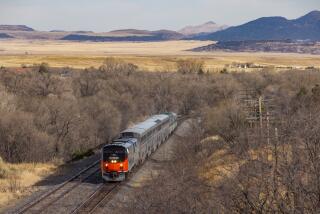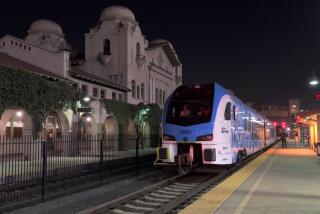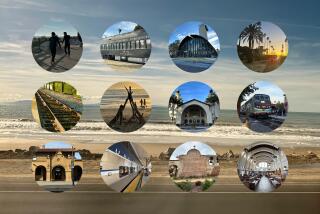Strike Forces Cancellation of 2 Amtrak Runs in State
A strike by Santa Fe Railway workers entered its third day Monday, forcing the cancellation of two Amtrak passenger trains in California and forcing passengers on a third train to take buses for part of their trip.
However, the commuter route between Los Angeles and San Diego, which carries about 4,000 passengers daily, remained unaffected by the strike, an Amtrak spokesman said.
The local and statewide effect on shipments of freight and produce was described as minimal by both union and railroad officials. Santa Fe supervisory personnel are handling freight operations “between two-thirds and three-fourths of normal,” said Robert Gehrt, Santa Fe director of public relations.
Test Train
Meanwhile, the “test train” that precipitated the walkout by more than 7,000 members of the United Transportation Union, the Brotherhood of Locomotive Engineers, and about 15 railroad unions arrived at the General Motors rail siding in Van Nuys before dawn Monday.
The 32-car train of “RoadRailer” units that can move on both railroad tracks and highways, had traveled from Chicago with car engines, axles and plastic parts, a General Motors spokesman said. It was unloaded without incident. The RoadRailer has a hydraulically operated undercarriage that allows it to run on either metal wheels or rubber tires.
In all, about 1,200 passengers were affected by the cancellations of the Southwest Chief, which normally operates between Los Angeles and Chicago, and the San Joaquin train between Oakland and Bakersfield, according to Gerald Jones, Amtrak’s acting station master in Los Angeles.
About 120 passengers on the Desert Wind, which runs between Los Angeles and Chicago, were taken by bus Monday from Los Angeles to Yermo, a station north of Barstow, where they boarded the train. The Desert Wind switches from strike-affected Santa Fe track to non-striking Union Pacific crews and track at Yermo.
Service to Resume
Normal service on the Desert Wind will resume today, Jones said, using only Union Pacific rails and crews.
According to John Easley, a United Transportation Union vice president in Santa Ana, the heavily used line between Los Angeles and San Diego was unaffected because no Amtrak facilities are adjacent to Santa Fe properties along the route. That is not the case with the other affected trains, he said.
The dispute between the railroad and its union workers stemmed from the number of crew members used to run the test train, and the distances each crew would travel on the test run.
Paul Thompson, international vice president of the transportation union, contended that the unions were still negotiating with the company on those issues when Santa Fe decided to start the test Saturday with non-union supervisory personnel in violation of union agreements dating from 1981. He accused the railroad of “union busting.”
Wants Assurances
No formal talks have been scheduled, Easley said, adding that the walkout will continue until the railroad makes clear its plans. “We have to have some assurance that they will not do this again,” he said.
Santa Fe spokesman Gehrt said the company had proposed to pay union crews to stay home and not operate the train after the company could not reach an agreement. “The whole idea of the test was to come up with a transportation method that was competitive with highways. We’ve been losing business to highways,” he said. “We felt we had to do it whether the union agreed or not.”
Gehrt said the company was pleased with the 45-hour test run. He said it showed that the railroad can make the trip more quickly than trucks can.
More to Read
Sign up for Essential California
The most important California stories and recommendations in your inbox every morning.
You may occasionally receive promotional content from the Los Angeles Times.










